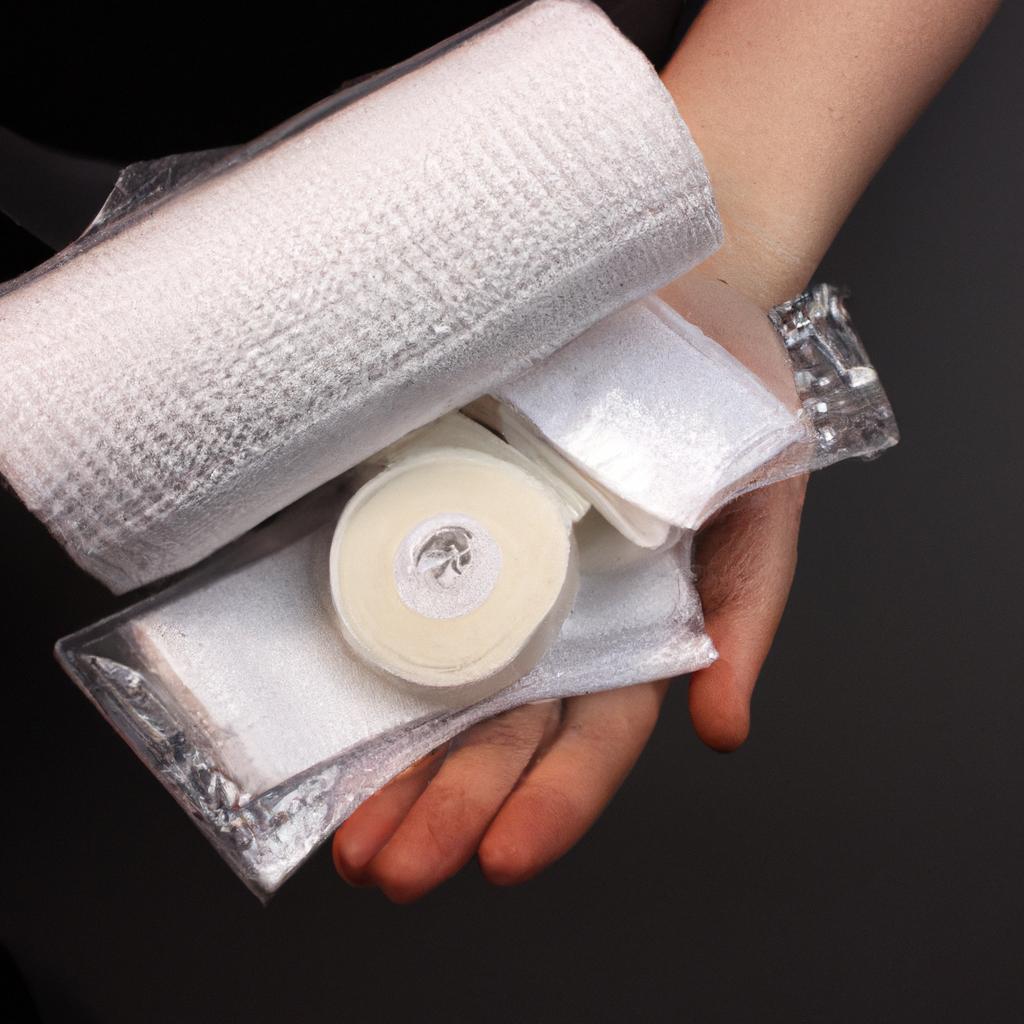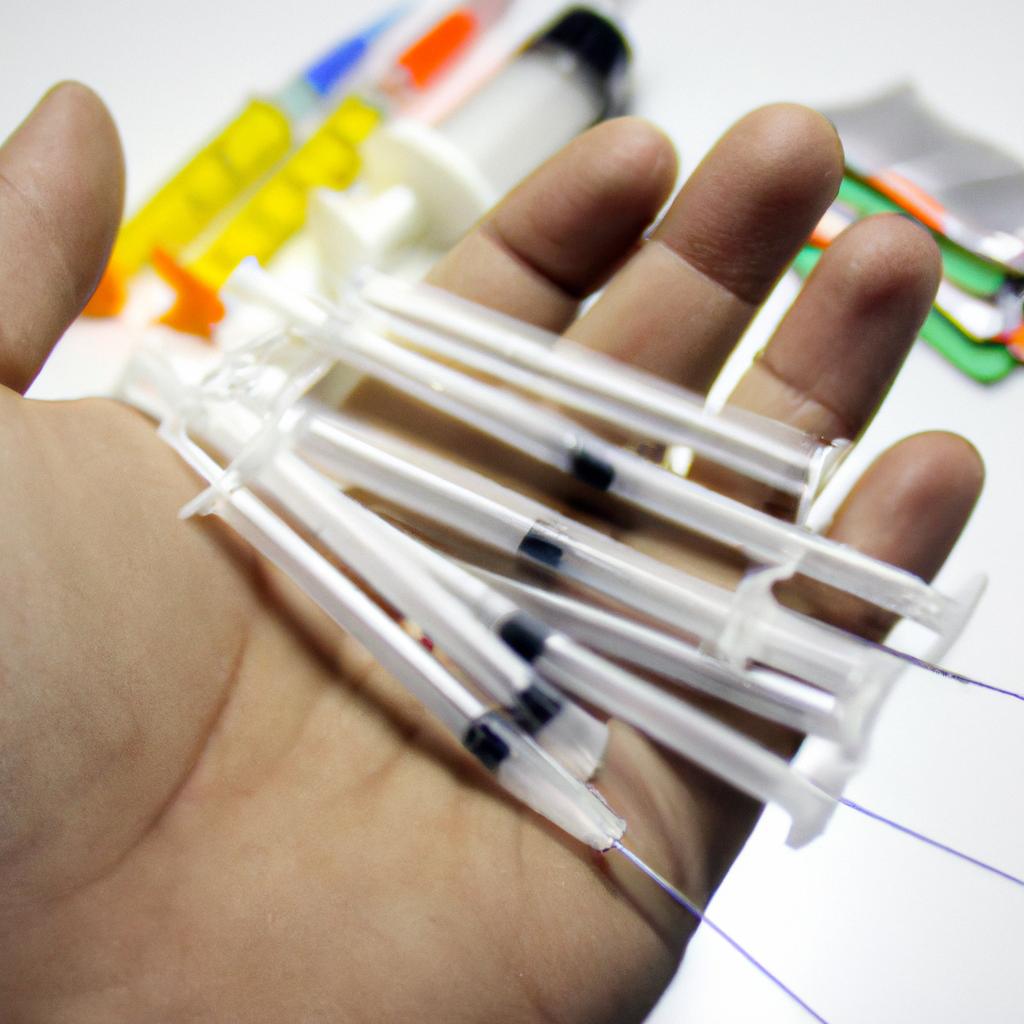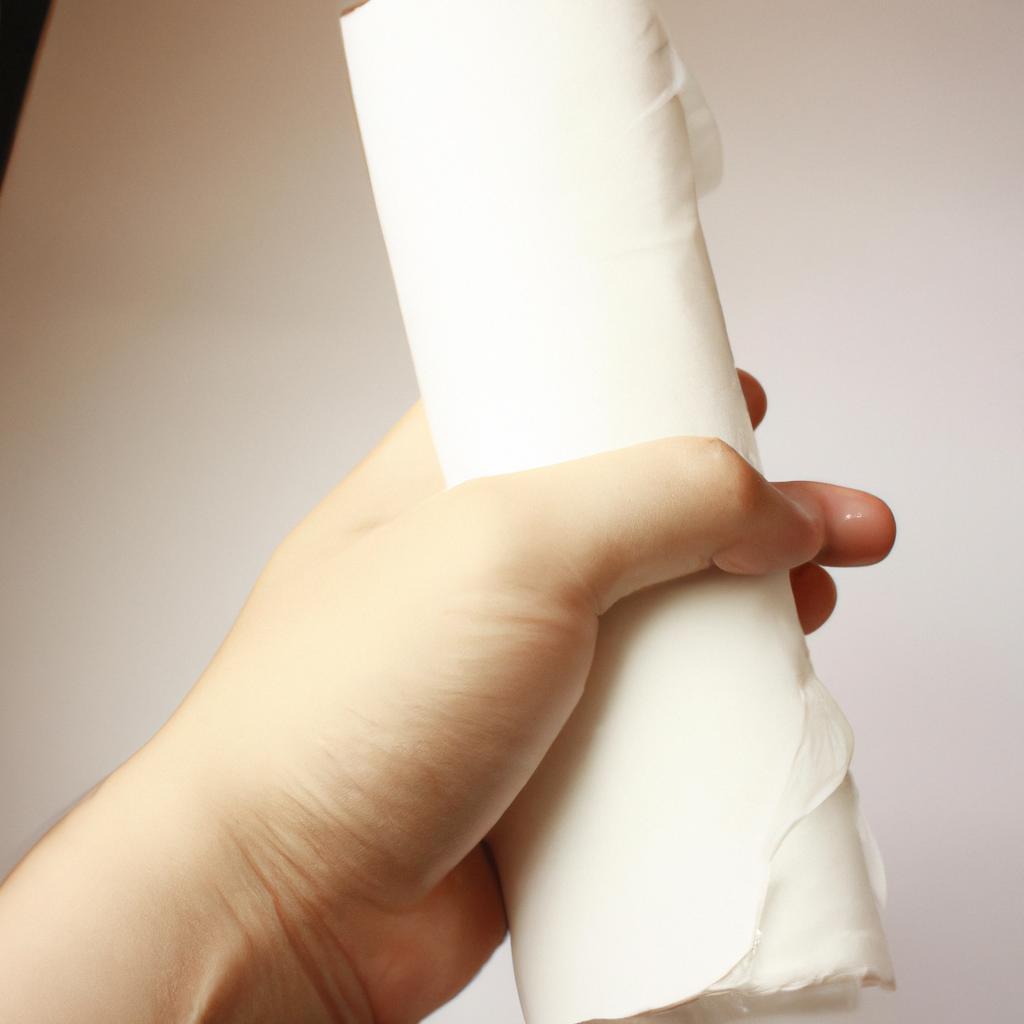Bandages are an essential component of medical care, used to cover wounds and promote healing. They come in a variety of forms, including adhesive bandages, gauze pads, and compression wraps. Understanding the different types of bandages available is crucial for healthcare professionals, as it allows them to select the most appropriate option based on the patient’s condition and needs. For instance, consider a hypothetical scenario where a young child sustains a minor cut while playing outdoors. In this case, an adhesive bandage would be suitable for covering the wound and protecting it from further contamination.
Instruments and supplies that fall under the category of disposables play a vital role in healthcare settings by ensuring safety and preventing infection transmission. Bandages are one such disposable item that serves multiple purposes beyond wound coverage. Besides providing physical protection to injuries, they also help control bleeding and minimize scarring. Furthermore, certain specialized bandages have additional functionalities such as promoting moisture balance or facilitating drug delivery through transdermal patches. Therefore, gaining comprehensive knowledge about different aspects of bandaging materials is indispensable for healthcare practitioners to optimize patient care outcomes effectively.
Types of Bandages
Bandages are essential medical supplies that serve various purposes in wound management and support. Understanding the different types of bandages available allows healthcare professionals to choose the most appropriate option for each patient’s specific needs.
To illustrate, let us consider a hypothetical scenario where a 45-year-old male presents with a deep laceration on his forearm caused by an accidental kitchen knife injury. In this case, the primary goal is to control bleeding and promote healing while minimizing the risk of infection.
One type of bandage commonly used in such situations is the adhesive strip or “plaster.” Adhesive strips provide a simple yet effective solution for small wounds like superficial cuts or abrasions that do not require extensive coverage. These thin, flexible strips adhere directly to the skin surrounding the wound, keeping it closed and protected from external contaminants.
On the other hand, more complex injuries may require compression bandages. Compression bandaging involves wrapping elasticized materials around injured limbs to apply pressure, reducing swelling and supporting proper blood circulation. This technique is particularly beneficial in cases of sprains, strains, or venous insufficiency.
Another category worth mentioning is absorbent dressings. These bandages play a crucial role in managing wounds with excessive exudate (fluid discharge). Absorbent dressings help keep wounds clean and dry while absorbing any excess fluid, preventing bacterial growth and promoting faster healing.
In summary, when it comes to choosing the right type of bandage for wound management and support, several factors need consideration: depth and severity of the injury, presence of exudate or bleeding, desired level of protection against contamination or infection, as well as patient comfort. By selecting appropriate options based on these considerations, healthcare professionals can effectively address patients’ unique needs during their healing process.
Moving forward into our discussion on Materials Used in Bandages…
Materials Used in Bandages
After exploring the various types of bandages, it is crucial to delve into the materials that are commonly used in their production. The choice of material plays a significant role in determining the effectiveness and usability of a bandage. For instance, let us consider a hypothetical scenario where a patient with a deep cut seeks medical attention. In this case, the healthcare professional would need to select an appropriate bandage material to ensure proper wound management.
There are several materials utilized in the creation of bandages, each possessing distinct properties that suit different purposes. To gain a comprehensive understanding, we will examine four common materials found in disposable bandages:
- Cotton: This natural fiber is widely used due to its softness and ability to absorb moisture. Cotton bandages provide comfort while facilitating airflow around wounds, preventing excessive perspiration or irritation.
- Elastic: Elastic materials offer flexibility and stretchability, making them suitable for securing dressings on joints or areas requiring constant movement. Their elastic nature allows for optimal compression without compromising mobility.
- Non-woven fabric: Made from synthetic fibers such as polyester or rayon, non-woven fabrics possess excellent strength and durability. These materials are often favored when higher levels of protection against contamination or external factors are required.
- Adhesive: Adhesive bandages incorporate adhesive properties directly onto the dressing material itself. This eliminates the need for additional tapes or fasteners and enables convenient application on small cuts or abrasions.
To emphasize how important these choices can be, imagine you have suffered a minor burn injury and require immediate relief. Now take a moment to reflect upon the following bullet points highlighting key considerations when selecting an appropriate bandage:
- Comfort: It is essential to choose a material that provides comfort during wear.
- Breathability: Opting for breathable materials reduces the risk of infection by promoting air circulation around the affected area.
- Flexibility: Depending on the location of the wound, a flexible bandage may be necessary to accommodate movement without compromising healing.
- Moisture absorption: Selecting materials that effectively absorb moisture helps maintain an optimal healing environment.
To further illustrate these characteristics, consider the table below comparing different bandage materials:
| Material | Comfort | Breathability | Flexibility | Moisture Absorption |
|---|---|---|---|---|
| Cotton | High | Moderate | Low | High |
| Elastic | Moderate | Moderate | High | Low |
| Non-woven | Moderate | High | High | Moderate |
| Adhesive | High | High | Low | Low |
In summary, understanding the various materials used in disposable bandages is essential for healthcare professionals and individuals alike. By carefully considering factors such as comfort, breathability, flexibility, and moisture absorption when choosing a bandage material, one can ensure effective wound management. With this knowledge at our disposal, we can now explore the different sizes and shapes of bandages and their respective applications.
Different Sizes and Shapes of Bandages
In the previous section, we explored the various materials used in bandages. Now, let us delve into the different sizes and shapes that these essential medical supplies come in.
To illustrate this point, consider a hypothetical scenario where a hiker sustains an ankle sprain while traversing uneven terrain. Upon examination by a healthcare professional, it is determined that applying a compression bandage would aid in reducing swelling and providing support to the injured joint.
Bandages are available in a range of sizes and shapes to cater to diverse medical needs. Here are some common variations:
- Triangular bandages: These versatile pieces of fabric can be folded into multiple configurations to serve as slings or provide support for fractures.
- Elastic adhesive bandages: Known colloquially as “self-adhesive wraps,” they offer flexibility and conformability, making them ideal for securing dressings on joints such as knees or elbows.
- Tubular gauze bandages: Designed like tubes, these elasticized garments are commonly used for holding dressings securely in place over cylindrical body parts like fingers or toes.
- Conforming bandages: Made from stretchy material, these types of bandages easily adapt to contours of the body and are frequently employed for dressing retention.
Now let’s take a moment to reflect upon how crucial these varied bandage options truly are when it comes to patient care. Consider the following emotional responses associated with their availability:
- Peace of mind knowing that there is a suitable bandage option for every injury
- Comfort derived from having secure dressings that stay in place throughout the healing process
- Confidence instilled in patients who feel supported both physically and emotionally during recovery
- Relief experienced by healthcare providers knowing they have access to tools tailored specifically for each case
Additionally, it may be helpful to visualize the differences between bandage types through the following table:
| Bandage Type | Key Features | Common Uses |
|---|---|---|
| Triangular bandages | Versatile, foldable fabric | Slings for arm or shoulder injuries |
| Elastic adhesive | Self-adhesive wraps | Securing dressings on joints like knees or elbows |
| Tubular gauze | Elasticized tubes | Holding dressings in place over fingers or toes |
| Conforming bandages | Stretchy material that adapts to contours | Dressing retention on various parts of the body |
In summary, understanding the different sizes and shapes of bandages is vital for effective wound care. By having a range of options available, healthcare professionals can provide tailored solutions that promote healing and enhance patient comfort.
[Transition sentence into subsequent section about “Common Uses for Bandages”] As we continue our exploration of bandages, let us now turn our attention to their common applications in medical practice.
Common Uses for Bandages
Bandages are a crucial component in the field of medicine, serving various purposes such as wound protection, immobilization of body parts, and aiding in healing. Understanding the different sizes and shapes available is essential for healthcare professionals to provide effective care. By choosing the appropriate bandage, medical practitioners can ensure optimal patient comfort and promote successful treatment outcomes.
For instance, consider a hypothetical scenario where a patient has sustained a deep laceration on their forearm. In this case, a sterile adhesive strip or butterfly closure would be suitable for closing the wound edges together, allowing it to heal properly. These small-sized bandages are commonly used for minor cuts and abrasions that require minimal coverage.
To cater to larger wounds or injuries involving joints, elasticized bandages play a vital role. These versatile bandages come in various widths and lengths to accommodate different body areas effectively. They possess stretchability properties that enable secure binding without compromising circulation. Elasticized bandages are often utilized in cases like sprained ankles or knee injuries where joint stabilization is required.
When dealing with burns or large surface-area injuries, non-stick dressings prove highly beneficial. These specialized bandages have a low-adherent layer that prevents them from sticking to the wound bed during dressing changes while still providing an adequate barrier against external contaminants. Non-stick dressings offer pain relief by minimizing trauma upon removal and facilitating proper wound healing.
In summary:
- Sterile adhesive strips/butterfly closures: Ideal for minor cuts and abrasions.
- Elasticized bandages: Suitable for stabilizing joints and accommodating larger wounds.
- Non-stick dressings: Effective for burn management and large surface-area injuries.
The knowledge regarding the diverse sizes and shapes of bandages empowers healthcare providers to make informed decisions when selecting appropriate options based on patients’ needs. In the subsequent section about “Proper Application of Bandages,” we will explore the step-by-step process of applying bandages correctly, ensuring optimal patient care and comfort.
Proper Application of Bandages
In this section, we will delve into the proper application of bandages to ensure optimal wound healing and patient comfort.
To illustrate the importance of proper bandage application, let us consider a hypothetical scenario involving an individual who sustains a deep cut on their forearm while cooking. Upon seeking medical attention, the healthcare provider assesses the wound and determines that it requires sutures for closure. After carefully cleaning and dressing the wound, they proceed to apply a sterile adhesive strip across the sutured area before securing it with a conforming stretch bandage. The purpose of this specific bandaging technique is to provide gentle support and protect the wound from external contamination during daily activities.
When applying bandages, there are several key considerations to keep in mind:
-
Wound assessment: Before selecting an appropriate type of bandage, it is essential to evaluate the size, location, and severity of the wound. This evaluation helps determine if additional padding or specialized dressings are necessary.
-
Proper technique: A consistent tension should be applied when wrapping the bandage around the affected area. It is crucial to avoid excessive tightness that may impede blood circulation or compromise tissue viability.
-
Material selection: Bandages come in various materials such as gauze, elastic fabric, or self-adhesive options. Each material has its advantages depending on factors like absorbency requirements or desired flexibility for joint injuries.
-
Regular monitoring: Once a bandage is applied, regular checks should be performed to ensure it remains intact and adequately supports wound healing. Any signs of infection or compromised integrity warrant immediate professional attention.
To further emphasize these considerations visually:
-
Emotional bullet point list:
- Ensure proper sizing and fit for maximum comfort.
- Choose breathable materials for improved airflow.
- Promote mobility by using flexible bandages.
- Regularly assess the bandage for any signs of complications.
-
Emotional table:
| Consideration | Importance | Benefit |
|---|---|---|
| Wound assessment | Crucial | Accurate selection of appropriate bandaging techniques |
| Proper technique | Essential | Prevents discomfort and promotes optimal healing |
| Material selection | Key decision factor | Enhances patient comfort and supports specific wound requirements |
| Regular monitoring | Vital | Early detection of issues ensures prompt intervention |
In summary, applying bandages correctly plays a vital role in wound care. By considering factors such as wound assessment, proper technique, material selection, and regular monitoring, healthcare providers can ensure effective bandage application that aids in wound healing while promoting patient comfort. Next, we will delve into essential tips for caring for and removing bandages without causing further harm or discomfort to the injured individual.
Tips for Bandage Care and Removal
Bandages play a crucial role in wound care, providing support and protection to promote healing. In the previous section on the proper application of bandages, we discussed various techniques and considerations for ensuring effective usage. Now, let us delve into some essential tips for bandage care and removal that will help optimize their effectiveness.
To illustrate the importance of proper bandage care, consider this hypothetical scenario: Sarah sustains a deep gash on her leg while hiking. After cleaning the wound thoroughly, she applies an appropriate dressing and secures it with a bandage. However, as time passes, Sarah notices increasing pain and discomfort around the wound area. This highlights the significance of regular inspection and maintenance when using bandages.
Here are some key tips to ensure optimal bandage care:
- Regularly check for signs of infection or complications such as redness, swelling, discharge, or increased pain.
- Keep the bandaged area clean by gently washing it with mild soap and water before reapplying a fresh dressing.
- Avoid exposing the bandage to excessive moisture or getting it wet unless otherwise instructed by a healthcare professional.
- Follow any specific instructions provided by your healthcare provider regarding changing frequency or special precautions.
In addition to these important steps for caring for your bandages properly, it is equally vital to know how to remove them safely. Improper removal can cause additional trauma to the wound site or surrounding skin. Here are some guidelines for safe bandage removal:
- Before removing the adhesive part of the bandage, moisten it with warm water or saline solution if applicable; this helps loosen its grip without causing unnecessary pain.
- Gently pull off the bandage following its natural direction parallel to the skin surface rather than pulling directly away from it.
- If resistance is encountered during removal due to dried blood or other factors adhering the bandage tightly, soak it again briefly before attempting further removal.
By adhering to these tips for bandage care and removal, you can minimize the risk of complications and discomfort. Remember, proper wound management is crucial for successful healing, and utilizing bandages correctly plays a vital role in this process.
| Emotional Response Bullet Points |
|---|
| – Ensuring optimal bandage care promotes faster healing and reduces the risk of infection. |
| – By following guidelines for safe bandage removal, unnecessary pain or trauma can be avoided. |
| – Regular inspection and maintenance are essential for identifying any potential complications early on. |
| – Proper wound management instills confidence in patients by providing effective support during the healing process. |
Table: Common Complications Associated with Improper Bandage Care
| Complication | Symptoms | Prevention |
|---|---|---|
| Infection | Redness, swelling, discharge | Maintain cleanliness; follow changing protocols |
| Skin irritation/allergy | Itching, rash | Choose hypoallergenic materials |
| Adhesive trauma | Pain upon removal | Moisten before removing; pull gently |
| Maceration (excessive moisture) | Softening/whitening of skin around wound | Avoid excessive wetting |
In conclusion, caring for your bandages properly is an integral part of wound management. Through regular inspection, maintaining cleanliness, and following appropriate techniques for both application and removal, you can ensure that your wounds heal effectively while minimizing any associated discomfort or complications.




